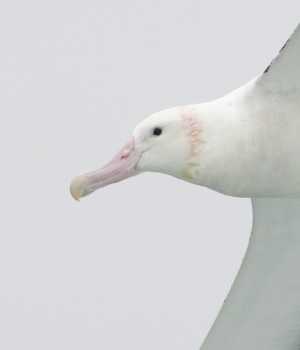The familiar pink staining on the necks of Wandering Albatrosses Diomedea exulans has been explained as due to "the birds snort[ing] or sneez[ing] explosively while in flight to expel fluid from their nasal tubes. The exhaled liquid is a mixture of a saline secretion from the salt glands (that all seabirds have) and stomach oil stained pink (or orange) from the birds' diet. This liquid then stains feathers lifted by turbulence as it moves closely past the head and neck due to laminar flow as an aerosol." (click here).
On 11 November 2011 John Chardine photographed a good example of pink (and yellowish-green) staining on a flying Wandering Albatross from the polar tourist vessel Fram to the north of the Scotia Sea in the South Atlantic at c. 53° 44'S, 42° 26'W.


With thanks to John Chardine, Canadian Wildlife Service.
John Cooper, ACAP Information Officer, 17 April 2012

 English
English  Français
Français  Español
Español